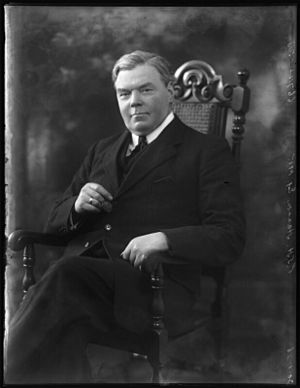Patrick Hannon facts for kids
Sir Patrick Joseph Henry Hannon (born in 1874, died in 1963) was an important figure in British politics and business. He was born in Ireland and became a Conservative and Unionist Party politician. He was also a successful industrialist (someone who owns or manages large businesses) and agriculturalist (someone involved in farming). People called him "one of Parliament's most colourful characters." Sir Patrick served as a Member of Parliament (MP) for Birmingham Moseley from 1921 to 1950. He was also active in the British Commonwealth Union, which promoted closer ties within the British Empire. He was born in County Sligo, Ireland. His father was a farmer, and Sir Patrick later helped many Irish workers and farmers.
Contents
Early Life and Education
Patrick Hannon grew up in tough times. He was very determined to get an education. He walked long distances to different schools, including Deerpark and Townaghbrack. To pay for his studies, he would collect turf (a type of fuel) in the summer. He then walked with his donkey to the town of Boyle, carrying two baskets of turf to sell. This hard work helped him attend the Royal College of Science and the Royal University of Ireland.
In 1887, he started working for the Midland Great Western Railway as a clerk in Loughrea, Ireland. There, he became lifelong friends with the famous Irish poet and playwright, William Butler Yeats.
Working in Agriculture
From 1896 to 1904, Hannon was very involved in Irish agriculture. He worked as an officer for the Irish Agricultural Organisation Society. This group helped set up local creameries (places where milk is processed) across the country. This was often difficult, as many people opposed the idea.
From 1901 to 1904, Hannon was a Director of the Irish Agricultural Wholesale Society. In this role, he studied farming practices around the world. He also visited the United States and Canada from 1902 to 1907 to promote Irish industries. Later, from 1907 to 1909, he worked for the government of Cape Colony (now part of South Africa) as a Director of Agricultural Organisation. He also became a Justice of the Peace there. He married Mary, the daughter of Thomas J Wynne from Castlebar.
Political Career
Sir Patrick Hannon moved to England in 1910 after his time in South Africa. He first tried to become an MP for Bristol East in 1910. He was part of the Tariff Reform League, which supported taxes on imported goods to protect British industries.
He was first elected as an MP for Moseley in a special election on March 4, 1921. He served in the House of Commons for almost 30 years, until 1950. As an MP, he did a lot for his local area. He was president of the Ideal Benefit Society, which helped working-class people buy their first homes. He also worked hard to support soldiers who had returned from war. For example, he helped get cars for seriously disabled veterans in Birmingham. He also supported "Haig Homes," a charity that provides housing for ex-servicemen.
Later Life and Achievements
Sir Patrick was a very religious man and always helped those in need. He was known for his kindness and sharp mind. He helped fund the rebuilding of St. Dunstan’s Roman Catholic Church in Kings Heath. He was also the treasurer of the Apostleship of the Sea, a Catholic Church group that supports sailors.
He was a key person in starting the Imperial Pioneers, which later became the British Commonwealth Union. His talents even extended to sports! He was the president of the famous football club Aston Villa. The club won the FA Cup in 1957 while he was president.
Sir Patrick also had a very successful business career. He was the chairman of major companies like BSA and Jaguar. The New York Times newspaper once said he was "an aggressive salesman for the Empire and the Commonwealth" for half a century. He led many campaigns to boost British trade around the world. He was president of the National Union of Manufacturers from 1935 to 1953.
Sir Patrick was given the title "Sir" (knighted) in 1946. He retired from Parliament in 1950, having never lost an election. He passed away in London on January 10, 1963.
An obituary (a notice of death) in the Catholic Herald newspaper praised his strong desire for knowledge. It said he "delighted in learning" and would walk five miles to school to learn physics. It also mentioned his great success in business and politics, and described him as "the most generous of men, an imperturbable companion, always warm-hearted and witty."


